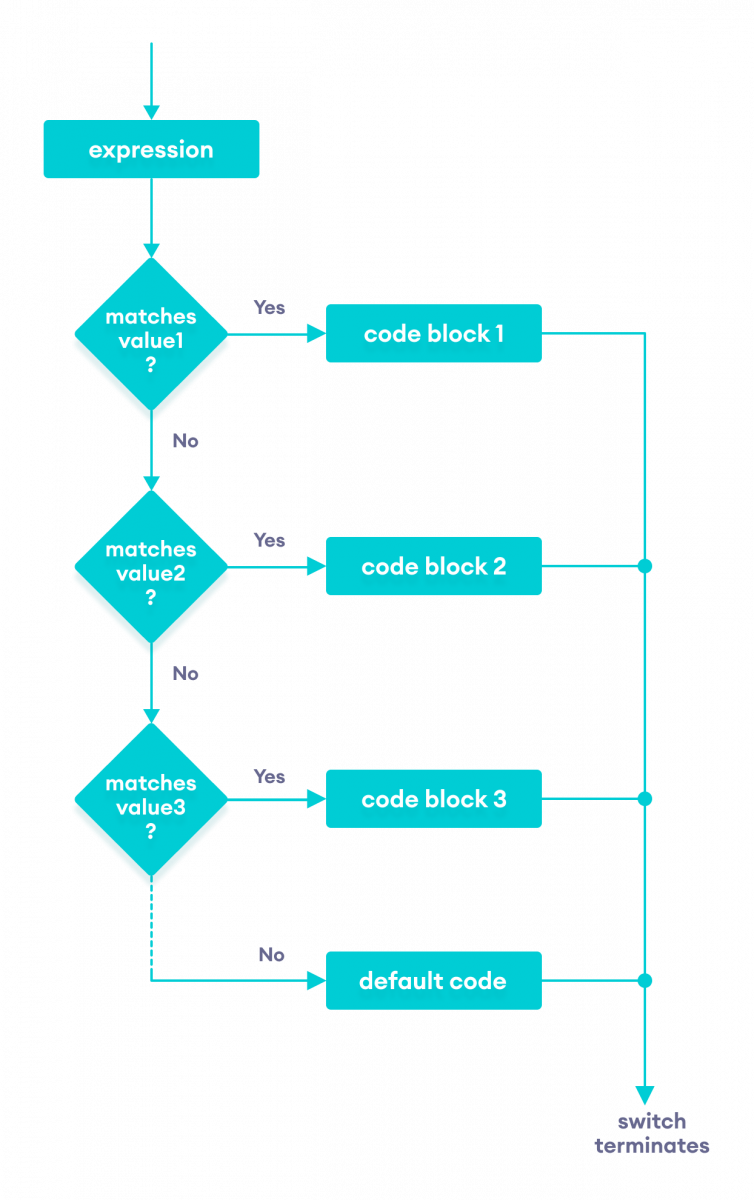The switch statement allows us to execute a block of code among many alternatives.
Syntax:
switch (expression) {
case value1:
// code
break;
case value2:
// code
break;
...
...
default:
// default statements
}
How does the switch-case statement work?
The expression is evaluated once and compared with the values of each case.
- If expression matches with value1, the code of
case value1are executed. Similarly, the code ofcase value2is executed if expression matches with value2 - If there is no match, the code of the default case is executed
Note: The working of the switch-case statement is similar to the Java if...else...if ladder. However, the syntax of the switch statement is cleaner and much easier to read and write.
Example: Java switch Statement
// Java Program to check the size
// using the switch...case statement
class Main {
public static void main(String[] args) {
int number = 44;
String size;
// switch statement to check size
switch (number) {
case 29:
size = "Small";
break;
case 42:
size = "Medium";
break;
// match the value of week
case 44:
size = "Large";
break;
case 48:
size = "Extra Large";
break;
default:
size = "Unknown";
break;
}
System.out.println("Size: " + size);
}
}
Output:
Size: Large
In the above example, we have used the switch statement to find the size. Here, we have a variable number. The variable is compared with the value of each case statement.
Since the value matches with 44, the code of case 44 is executed.
size = "Large";
break;
Here, the size variable is assigned with the value Large.
Also Read:
Flowchart of switch Statement

break Statement in Java switch...case
Notice that we have been using break in each case block.
...
case 29:
size = "Small";
break;
...
The break statement is used to terminate the switch-case statement. If break is not used, all the cases after the matching case are also executed. For example,
class Main {
public static void main(String[] args) {
int expression = 2;
// switch statement to check size
switch (expression) {
case 1:
System.out.println("Case 1");
// matching case
case 2:
System.out.println("Case 2");
case 3:
System.out.println("Case 3");
default:
System.out.println("Default case");
}
}
}
Output
Case 2 Case 3 Default case
In the above example, expression matches with case 2. Here, we haven't used the break statement after each case.
Hence, all the cases after case 2 are also executed.
This is why the break statement is needed to terminate the switch-case statement after the matching case. To learn more, visit Java break Statement.
default Case in Java switch-case
The switch statement also includes an optional default case. It is executed when the expression doesn't match any of the cases. For example,
class Main {
public static void main(String[] args) {
int expression = 9;
switch(expression) {
case 2:
System.out.println("Small Size");
break;
case 3:
System.out.println("Large Size");
break;
// default case
default:
System.out.println("Unknown Size");
}
}
}
Output
Unknown Size
In the above example, we have created a switch-case statement. Here, the value of expression doesn't match with any of the cases.
Hence, the code inside the default case is executed.
default:
System.out.println("Unknown Size);
Note: The Java switch statement only works with:
- Primitive data types: byte, short, char, and int
- Enumerated types
- String Class
- Wrapper Classes: Character, Byte, Short, and Integer.
Also Read: